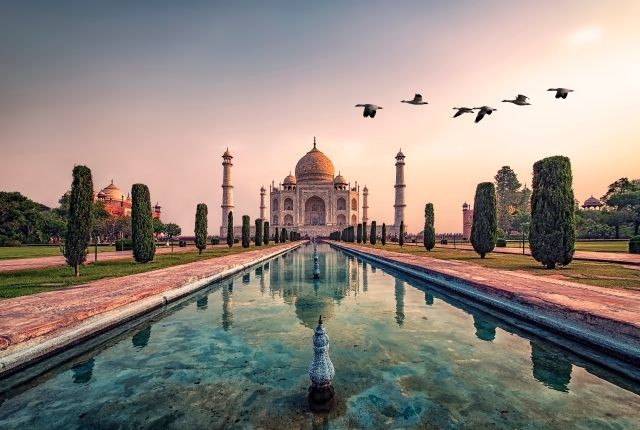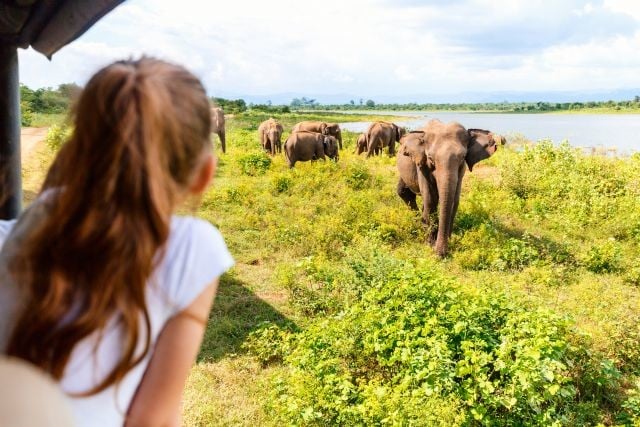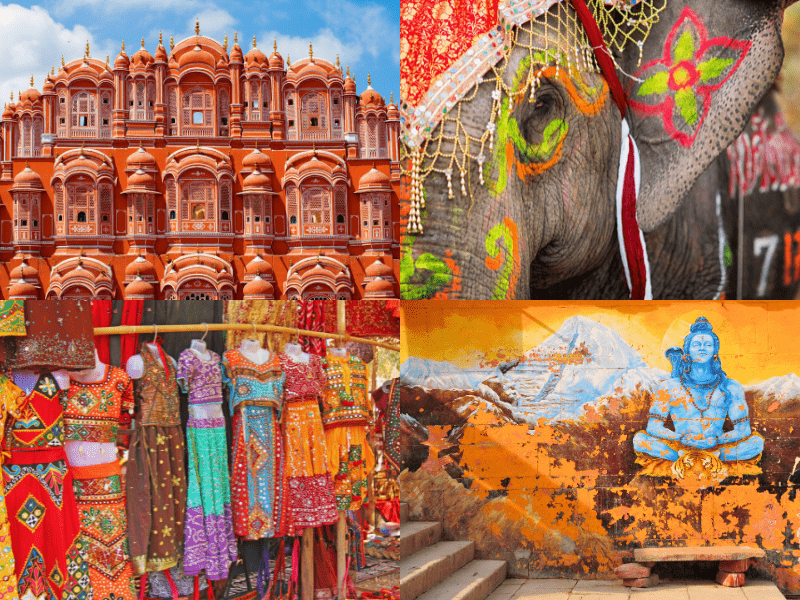Description
India's Golden Triangle and Ranthambore National Park offer a fascinating blend of history, culture, and nature.
The Golden Triangle comprises three cities: Delhi, Agra, and Jaipur, and it is called so because of the triangular shape they form on a map. The area is known for its rich cultural heritage, vibrant markets, and impressive architecture.
Delhi is the capital city of India. The city is a bustling metropolis with a mix of old and new. In Old Delhi, you can explore the labyrinthine lanes of the Chandni Chowk market, take a rickshaw ride through the narrow alleys, and visit the Jama Masjid, one of the largest mosques in India. In New Delhi, you can see the grandeur of British colonial architecture, visit the India Gate, and explore the museums and galleries.
Agra is home to the iconic Taj Mahal, one of the Seven Wonders of the World. The Taj Mahal is a stunning marble mausoleum built by the Mughal emperor Shah Jahan in memory of his beloved wife Mumtaz Mahal. Apart from the Taj Mahal, Agra also has other Mughal-era monuments like the Agra Fort and the tomb of Itimad-ud-Daulah.
Read Our Blog - ''How To Survive Visiting India For The First Time'
Jaipur is the vibrant capital city of the desert state of Rajasthan. Jaipur is also known as the Pink City because of the pink-colored buildings in the old city. The city is famous for its beautiful palaces, forts, and gardens. The City Palace, Hawa Mahal, Jantar Mantar, and Amber Fort are some of the popular tourist attractions in Jaipur.
Ranthambore National Park, which is located in the state of Rajasthan, is home to tigers, leopards, and other wildlife. The park is named after the Ranthambore Fort, which is located within its boundaries. The fort is a UNESCO World Heritage Site and offers a panoramic view of the park. A safari in Ranthambore National Park is an unforgettable experience where you can see tigers in their natural habitat.
Visiting India's Golden Triangle and Ranthambore is a great way to experience the diverse culture, history, and wildlife of India. It offers a perfect blend of ancient monuments, vibrant cities, and wildlife, making it a trip of a lifetime.









Itinerary Downloadable Itinerary
Day 1 Day 2 Day 3 Day 4 Day 5 Day 6 Day 7 Day 8 Day 9
Delhi
Today you arrive in Delhi and will be transferred to your hotel to check in.
Delhi, the soul of India and a mélange of cultures, encapsulates two very different worlds, the “old’ and the “new” giving a feel of both ancient and modern India. The city is nestled in the lap of majestic Yamuna River and presents the soul of India in its true self. Over thousands of years, it has wooed rulers, fascinated plunderers, and tried historians with details. Even today, Delhi preserves an enviable heritage; it’s a city always on the move. The city is sprinkled with captivating ancient monuments, picturesque gardens, magnificent museums, a vivacious performing arts scene and some of the sub-continent’s best restaurants. This city of contrasts is a treasure trove for tourists.
Rest of the day is at leisure.
Meals: Dinner
Accommodation: The Oberoi New Delhi with a Complimentary upgrade to a Premier Room
Delhi
This morning after breakfast, proceed for the full day sightseeing of Old and New Delhi.
Introduction to Delhi starts with a heritage walk to Old Delhi (Shahjahanabad) visiting Red Fort, Jama Mosque, Chandni Chowk and Raj Ghat. In the 17th century, the Mughal emperor, Shah Jahan, made his capital in Shahjahanabad, the area that broadly covers present-day Old Delhi, also called the walled city. Jama Mosque is the largest and most well-known mosque in India. It is flanked by Red fort on one side and old city Chandni Chowk on another side. Built by Shah Jahan in 17th century, Jama Masjid is one of the most crowded destinations in Delhi for pilgrims and tourists. It is a great place of Muslim pilgrimage. There are three entrances to the Courtyard- on the East, North and South. Since the mosque is laid on a hillock, the steps climbing up to this are steep. The eastern gate has 774 steps. Chandni Chowk is the oldest market places of Old Delhi. The origin of Chandni Chowk dates back to the Mughal era in Indian history. According to legends, Chandni Chowk market was established during the reign of the Mughal Emperor Shah Jahan and was designed by Jahanara-Emperor Shah Jahan's favorite daughter. Today this market is considered to be one of the busiest markets in the world.
Raj Ghat lies on the banks of the river Yamuna. It is the last resting place of Mahatma Gandhi, Father of the Nation. It also houses two museums dedicated to Gandhi. At the Gandhi Memorial Museum, you can catch a documentary on the life of this noble soul and the philosophy of the Sarvodaya Movement.
The British Empire established their capital in New Delhi with much fanfare in 1911. King Edward of Britain came to Delhi and designated the leading British Architect, Edward Lutyen’s, with the task of building the new capital in Delhi. Lutyen’s Delhi primarily consists of the administrative area of the capital, India Gate and the Viceroy’s House (which is now known as Rashtrapati Bhawan). A visit to Delhi is incomplete without going to Lutyen’s Delhi which one can say, is the place where the Central Government of India currently resides and works from.
Gurudwara Bangla Sahib is located near the main Connaught Place in Delhi. It has developed into a center of pilgrimage for thousands of people every day. People from various religions, castes and places visit this holy place.
Later, you will visit to Humayun’s Tomb and Qutab Minar.
Humayun’s Tomb, a UNESCO World Heritage Site, is the first substantial example of Mughal architecture in India. This magnificent garden tomb was built in 1565, nine years after the death of Humayun, the second Mughal Emperor, by his widow Bega Begam. Inside the walled enclosure are garden squares with walkways, water channels and a mausoleum with a double dome in the center. Humayun’s Tomb is often considered a precursor to the Taj Mahal owing to the stylistic similarity of its structures. Qutab Minar with a height of 234 feet is considered as the tallest individual tower in the world. It is one of the many masterpieces that depicted the sheer brilliance of the Mughal architects of those times. It was constructed under the rule of Sultan Qutub-ud-din Aibak in 1199. It is surrounded by other ancient monuments which are collectively called Qutub complex.
Meals: Breakfast and Dinner
Accommodation: The Oberoi New Delhi with a Complimentary upgrade to a Premier Room
Delhi - Agra
After breakfast, travel by road to Agra.
Famed with one of the Seven Wonders of the World - Taj Mahal, historical monuments, architectural grandeur ventures and the beauty of marbles, Agra thrives as one of the tourist destination in India. The city is known for its superb inlay work on marble by craftsmen supposedly with a lineage dating back to the Mughals. Agra’s handicrafts also include carpets, gold thread embroidery and leather shoes.
Upon arrival in Agra, you will be transfered to you hotel for check in.
Rest of the day is at leisure.
Meals: Breakfast and Dinner
Accommodation: Oberoi Amarvilas
Agra
Early this morning you will visit the Taj Mahal.
Taj Mahal is one of the Seven Wonders of the World that symbolizes the love of the Mughal Emperor Shah Jahan for his beloved wife Mumtaz Mahal’s final resting place. Taj Mahal is widely recognized as "the jewel of Muslim art and one of the universally admired masterpieces of the world's heritage. It was completed in 1653 AD, it is believed that it took nearly 22 years to complete the grandeur palace. There are 22 small domes over the Taj Mahal, denoting the same. To experience the beauty of this architectural marvel, it needs to be viewed at different times of the day and year. The white marble building changes its hue with the variations in the daylight.
Note: Taj Mahal is closed on Fridays. The time for the sunrise visit of Taj Mahal during winters may vary depending upon the weather / fog conditions.
Return to your hotel for breakfast.
Later you will visit Agra Fort.
The Agra Fort is one of the most important and robustly built strongholds of the Mughals, embellished with number of richly decorated buildings encompassing the imposing Mughal style of art and architecture. The fort contains a maze of buildings forming a small city within a city. The Agra Fort offers great views of the Taj Mahal from across the Yamuna.
Rest of the day is at leisure.
Meals: Breakfast and Dinner
Accommodation: Oberoi Amarvilas
Agra - Ranthambore
After breakfast, you will be driven to Ranthambore.
The Ranthambore National Park was once the private hunting ground of the Maharaja of Jaipur. The park is located in the Sawai Madhopur district of south-eastern Rajasthan, which is about 130 km from Jaipur. At present, the national park is a part of Project Tiger and is one of the few places in the world, where over 300 species of birds and wildlife such as tigers, leopards, nilgai, black buck and Indian black boar graze with gay abandon. Visiting Ranthambore is a dream of every wildlife enthusiast; the park is renowned for tigers and is one of the best places in India to sight the majestic species.
Upon arrival in Ranthambore, you will be transfered to your hotel.
Rest of the day is at leisure.
Meals: Breakfast, Lunch and Dinner
Accommodation: The Oberoi Vanyavilas in a Luxury Tent
Ranthambore
Early morning and afternoon, enjoy exclusive jungle safari by 4x4 jeep.
Jeep Safari is the best way to explore the Ranthambore National Park. You would be accompanied by the very best naturalist guides. There are two safaris each day in Ranthambore National Park, one in the morning and another in the afternoon. More than in any other park or sanctuary in India, tigers are easily spotted here in daylight. It is very easy to chance upon a tiger lolling around lazily in the sun, or feverishly hunting down Sambhar around the lakes.
Return to the hotel for breakfast and enjoy the rest of the day at leisure.
Meals: Breakfast, Lunch and Dinner
Accommodation: The Oberoi Vanyavilas in a Luxury Tent
Ranthambore - Jaipur
After breakfast, you will travel by road to Jaipur.
Adorned with pink sandstone palaces, majestic forts and verdant green gardens against a scenic backdrop of the Aravali hills, Jaipur represents the charm of India’s rich past and the sophistication of a flourishing metropolis. The city of Jaipur was founded by Sawai Jai Singh II in 1727 AD and is commonly known as the ‘Pink City” because of the color of the stone used exclusively in the walled city. The bustling bazaars of Jaipur, famous for Rajasthani Jewelry, fabrics and shoes, possesses a timeless quality and are surely a treasure – trove for the shoppers. This fascinating city with its romantic charm takes you to an epoch of royalty and tradition.
Upon arrival in Jaipur, you will be transfered to your hotel.
Rest of the day is at leisure.
Meals: Breakfast and Dinner
Accommodation: Oberoi Rajvilas
Jaipur
After breakfast, proceed to visit the ancient capital of Amber to see the fabulous Amber Fort.
Amer Fort, also spelled and pronounced as Amber Fort is located in Amer, 11 Km from Jaipur. The Fort is a UNESCO World Heritage Site and the principal tourist attractions in the Jaipur. The construction of the fort was started by Man Singh I in 1592. The fort boasts of an artistic grandeur and structural expertise. It is a reminiscent of the bravery and courage of the mighty Rajputs, who had played a remarkable role in the history of medieval India. You enjoy a magnificent Elephant Ride to reach the magnificent Amber Fort.
Note: Amber Fort remains closed on Public holidays and on the day of Holi celebration.
Take a photo stop near ‘Jal Mahal’. Jal Mahal, also known as ‘Water Palace’ is a palace in the middle of the Man Sagar Lake in Jaipur city, the capital of the state of Rajasthan, India. The palace and the lake around it were renovated and enlarged in the 18th century by Maharaja Jai Singh II of Amber. Continue the tour with the visits of City Palace and Hawa Mahal. Later, explore the vibrant local markets on a Tuk-Tuk, popularly known as Bapu Bazar.
The City Palace is the former residence of the Royal Family of Jaipur. It is located in the heart of the walled city. The huge complex of courtyards, gardens, and buildings blend both Rajasthani and Mughal architecture. The palace also has a museum of Maharaja Sawai Man Singh II where on display are a wide array of royal costumes, some very exquisite and precious Pashmina (Kashmiri) shawls, Banarasi Silk sarees, Sanganeri prints and folk embroidery.
Note: City Palace remains closed on Public holidays and on the day of Holi celebration.
Drive past magnificent Hawa Mahal and walk through the old bazaar of Jaipur. Hawa Mahal is perhaps the most well-known architectural landmark of Jaipur. An imposing structure in the city’s signature pink color, Hawa Mahal is a unique palace as it does not have any rooms or halls. It is a five-storeyed structure embellished with numerous little windows and balconies. It was designed as a viewing gallery for the women of the royal household, the windows and balconies of this palace feature delicate latticework that is astonishing in detail and level of craftsmanship.
Note: Bapu Bazaar remains closed on Sunday.
Meals: Breakfast and Dinner
Accommodation: Oberoi Rajvilas
Jaipur - Delhi
After breakfast, you will travel by road to Delhi and transfer to New Delhi International airport to board your flight for your onward journey.
If you are wanting to extend your stay in Delhi, please enquire with our Customer Service team who can arrange this for you.
Meals: Breakfast
Inclusions & Exclusions
Inclusions
- 8 nights’ accommodation on double / twin sharing basis
- Daily Breakfast and dinner will be included in mentioned hotels during the stay
- Ranthambore where the stay is inclusive of all the three meals
- Local English speaking tour guide at every destination for sightseeing
- All arrival, sightseeing & excursions as per the itinerary by an Air-Conditioned vehicle
- 2 Jungle Safari in an exclusive Jeep in Ranthambore
- Entrance Fees at the monuments as per the itinerary
- Water bottles, Hand Sanitizers, Wet and Dry tissues in the vehicle throughout the trip
- Ground Services Representative for assistance on all arrival & departure at airport
- All current applicable taxes
Your Oberoi Accommodation:
- Delhi - The Oberoi New Delhi with a Complimentary upgrade to a Premier Plus Room
- Agra - The Oberoi Amarvilas in a Premier Room
- Ranthambore - The Oberoi Vanyavilas in a Premier Room
- Jaipur - The Oberoi Rajvilas in a Premier Room
Exclusions
- International Flights
Visa fees - Travel insurance (strongly recommended)
- Meals & drinks not mentioned
- Any additional requests
Solo Supplement: There is a single supplement of between $3199 and $6299 on this trip depending on your time of travel.
Extra Services: Wanting to book pre and/or post-accommodation? Need a quote on a flight to India? Contact us for more details!
Travel Insurance: We recommend Covermore travel insurance. To quote and book, please click HERE.
Travelling on your own? Why not join the Traveldream Solo Travellers Facebook group where you can interact with other travellers.
Why not consider extending your trip to Sri Lanka with our
'13 Day Private Tour | Amazing Sri Lanka'
WAKE UP HERE! Read the latest from the Official Traveldream Blog



